Renovating Your Bathroom: A Step-by-Step Guide
Introduction
Embarking on a bathroom renovation can be an exciting yet challenging endeavor. Whether you’re looking to enhance the functionality, update the aesthetics, or address underlying issues, proper planning and a systematic approach are crucial. In this comprehensive guide, we’ll explore the optimal order in which to renovate a bathroom to ensure a smooth and successful project.
1. Planning and Design
Before picking up a hammer or selecting tiles, thorough planning and design are essential. Start by assessing your needs and envisioning the desired outcome. Consider factors such as layout, fixtures, storage, and overall aesthetics. Engage with design tools or consult with a professional to create a detailed plan. This phase sets the foundation for a cohesive and well-executed renovation.
1.1 Budgeting

Establish a realistic budget that encompasses all aspects of the renovation, including materials, labor, and unexpected expenses. Having a clear financial plan helps prioritize choices and prevents overspending.
1.2 Permits and Regulations
Check local building codes and regulations to ensure compliance. Obtain any necessary permits before starting the renovation to avoid delays and potential legal issues.
2. Demolition
Once the planning is complete, it’s time to roll up your sleeves and begin the demolition phase. Remove existing fixtures, tiles, and any elements being replaced. Exercise caution during this stage to avoid damaging structural elements that will remain in place.
2.1 Plumbing and Electrical Inspection
Inspect and address any plumbing or electrical issues exposed during demolition. This is the opportune time to replace old pipes, update wiring, or address any hidden problems.
2.2 Structural Repairs
Address any structural issues, such as water damage or rot, before proceeding with the renovation. Repairing the foundation ensures a stable and durable bathroom.
3. Rough-In Work
With a clean slate, focus on the rough-in work, which involves installing new plumbing lines, electrical wiring, and framing for additional fixtures. This stage lays the groundwork for the final layout.
3.1 Plumbing Installation
Install new plumbing lines based on the updated design. Ensure proper drainage and water supply connections for the sink, toilet, bathtub, and shower.

3.2 Electrical Wiring
Lay out the electrical wiring according to the updated plan. Install lighting fixtures, outlets, and switches in their designated locations.
3.3 Framing for Fixtures
Frame the space for fixtures such as the bathtub, shower, and vanity. This step provides the necessary support for the final installations. https://sydneyhomesandrenovations.com.au/bathroom-renovations-hills-district/
4. Insulation and Drywall
Once the rough-in work is complete, focus on insulation and drywall installation. Proper insulation ensures energy efficiency, while drywall creates a smooth surface for the final finishes.
4.1 Insulation
Install insulation to regulate temperature and prevent moisture buildup. This step is crucial for creating a comfortable and energy-efficient bathroom.
4.2 Drywall Installation
Hang and finish drywall to create a solid foundation for paint or tile. Pay attention to seams and corners for a seamless appearance.
5. Flooring and Wall Finishes
With the structural elements in place, turn your attention to flooring and wall finishes. Choose materials that align with your design preferences and withstand the moisture-prone environment of a bathroom.
5.1 Flooring Installation
Install the chosen flooring material, whether it’s tile, vinyl, or hardwood. Ensure proper sealing to prevent water damage and enhance durability.
5.2 Wall Finishes
Apply wall finishes, such as paint or tile, to achieve the desired aesthetic. Consider moisture-resistant options for longevity and ease of maintenance.
6. Fixture Installation
As the cosmetic elements come together, it’s time to install fixtures and accessories. This includes placing the sink, toilet, bathtub, shower, and any additional features.
6.1 Plumbing Fixture Installation
Install plumbing fixtures, connecting them to the previously installed plumbing lines. Check for leaks and ensure proper functionality.
6.2 Vanity and Cabinets
Place and secure the bathroom vanity and cabinets in their designated locations. Ensure proper alignment and functionality of drawers and doors.
7. Final Touches and Finishing Details
The final touches and finishing details bring the entire renovation project together. Pay attention to small elements that contribute to the overall appeal and functionality of the bathroom.
7.1 Lighting Fixtures
Install the selected lighting fixtures to enhance visibility and ambiance. Consider fixtures that complement the overall design.
7.2 Hardware and Accessories
Attach hardware such as towel bars, toilet paper holders, and other accessories. These details add a polished and functional touch to the completed space.
7.3 Final Inspection
Conduct a thorough inspection of the renovated bathroom to ensure everything meets quality standards. Address any remaining issues before declaring the project complete.
Conclusion
Renovating a bathroom involves a series of carefully planned steps, from initial design to the final touches. By following this systematic order, you can streamline the renovation process, reduce the likelihood of setbacks, and achieve a beautifully revamped bathroom that meets both your aesthetic and functional needs. Remember to approach each stage wit

